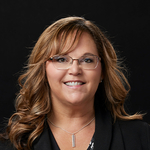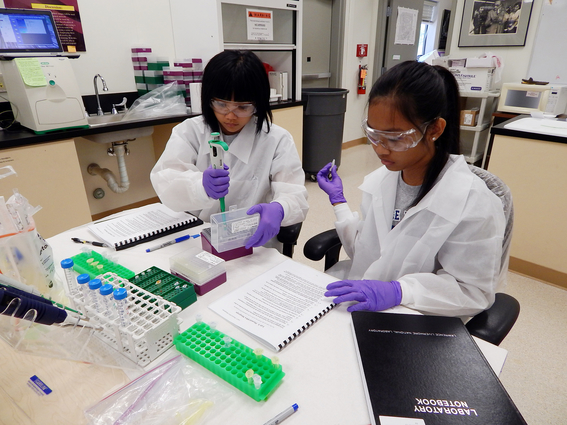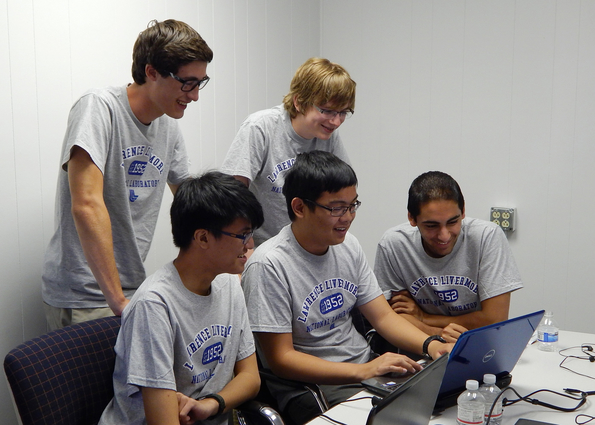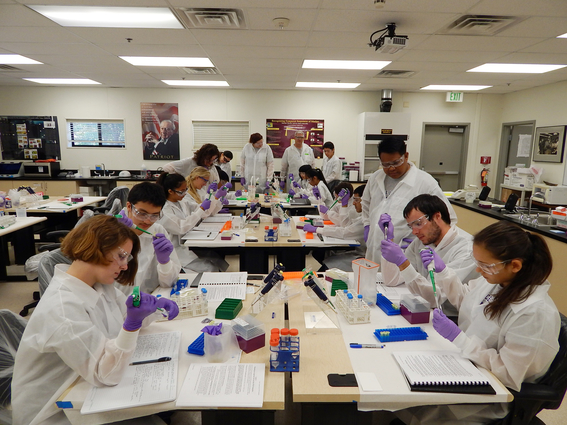Summer workshops provide hands-on learning for high school students
Each summer, college students from around the world descend upon the Lawrence Livermore National Laboratory (LLNL) to conduct research and experience what it is like to work at a national laboratory. While hosting college students at LLNL is commonplace, the presence of high school students onsite is a rarity.
This summer, the University Relations and Science Education Program at LLNL hosted two summer workshops at the Edward Teller Education Center (ETEC) for high school students and their teachers to delve into science through hands-on learning.
These workshops have provided teachers and students an opportunity to work together outside of the school environment, not just to learn science, but to "do" science.
Student Research Academy in Computational Modeling
The Student Research Academy in Computational Modeling program is an innovative follow-up program to the Computational Modeling and Simulation Teacher Research Academy (TRA) that was launched last year and taught local teachers how to use the simulation software called NetLogo. The teachers, Richard Newton and Dean Reese from Tracy High School, Rodger Johnson from Monte Vista High School and Robin Groch from San Ramon Valley High School, brought NetLogo back to their classroom in an effort to expose students to computer simulation in science. For this workshop, participating teachers were welcomed back along with five students handpicked to pilot the program.
The students, Joshua Abraham, Amit Grewal and Miguel Patrick Taruc from Tracy High School, Rowen Banta from Monte Vista High School, and Evan Laufer from San Ramon Valley High School, spent the week learning techniques and practices in computational modeling and simulation.
"Computational modeling is a fantastic tool that allows students to greatly expand their skill set and develop a deeper understanding of both the computer programming and the science that it supports," Johnson said. "Students are strong intuitive learners when it comes to programming and given the chance they will produce amazing results that not only demonstrate creativity but also show they know how to link the underlying science and mathematics to produce a meaningful model."
While most of the students were nervous going into the program, they quickly gained confidence in their coding skills and were excited to learn more about computational modeling and coding. They now see LLNL as somewhere they could pursue a career.
Tracy senior Taruc was inspired by his week at LLNL."I thought this was such an amazing experience in that we, as high school students, had the opportunity to come together for our goal of creating a unified model. The great thing about this is that we were on the site of the Lawrence Livermore National Laboratory, which created this work atmosphere that almost overwhelmed me in how science brings people together to make amazing contributions to the world."
Reese has spent several summers teaching the TRA and was excited to bring the curriculum to these students. Throughout the week, the students generated a model of the carbon cycle and incorporated extrapolated trends from the National Oceanic and Atmospheric Administration (NOAA) data on the parts per million (ppm) concentration of carbon dioxide (CO 2 ) in the atmosphere. Reese was impressed with the speed at which the students developed their coding skills. "Within a few short days, the students managed to create a fairly sophisticated model of the carbon cycle," he said."It was great to see students from three different high schools collaborating."
Laufer, a sophomore at San Ramon Valley High School, enjoyed meeting new people and found the LLNL tours very interesting. "During the week, I learned a lot about computational modeling and how to make a good model. I also learned a lot about the carbon cycle, global warming and how the actions of humans will affect the world in the future. It caused me to realize that if we don't act now there could be dire consequences very soon."
The weeklong workshop included multiple tours of the Lab to highlight ways in which Livermore scientists utilize computational modeling in their research and concluded Friday with the students presenting their model to the students and teachers participating in the biotech program.
LLNL Student Scholars Progra (SSP)
Now in its third year, the LLNL Student Scholars Programruns in conjunction with the Waksman Student Scholars Program (WSSP) at Rutgers University in New Brunswick, New Jersey. In this program, selected students and their teachers come to the Lab for a two-week immersion program in biotechnology and bioinformatics.
The workshop instructors, Erin McKay from Tracy High School and Jeff Austin from Modesto High School, are long time participants in the TRA, having also attended the 2011 summer institute at Rutgers University in New Jersey to learn the curriculum and prepare for their roles as master teachers.
The 2014 SSP research project focuses on the DNA sequence analysis of genes from the duckweed plant (Landoltia punctata), and how these genes compare to those found in other species. Duckweed, a fresh-water aquatic plant, is interesting to the scientific community because of its use in bioremediation, and its potential use as a biofuel.
Each student receives a number of clones obtained from a DNA library made from an aquatic plant species. The students isolate and identify the DNA segments in the hopes of obtaining novel DNA sequences for publication in the international DNA database, GenBank. It is a unique opportunity for these high school students to not only broaden their knowledge of molecular biology, but also publish a novel gene.
McKay has enjoyed exploring molecular genetics with the students. "This program has allowed the students to develop valuable skills using common biotechnology equipment as well as facilitating their transition into a deeper level of thinking regarding protein structure and the central dogma of biology."
This summer, 14 students participated in the program. They are: Frances Carcellar and Monique Porcella from Granada High School; Emma Austin, Frank Deng, Manraj Hans and Alexander Wiegman from Modesto High School; Maximilliam Khan, Trevor Mahoney and Benjamin Pollak from Monte Vista High School and Jessica Hurst, Dolly Lin and Hamza Raniwala from Tracy High School. Michael Sana, a teacher from Waipahu High School in Oahu, Hawaii also attended the workshop and brought two students, Maria Excellsis Dela Cruz and Jecel Lawi-an, with him.
Dela Cruz, a junior at Waipahu High School, traveled 2,300 miles for the opportunity to work with students and teachers from California. "Because of this program I've met new people and gained valuable experience and knowledge that will serve as a foundation to my understanding of molecular biology and bioinformatics," she said. "The program introduced me to different aspects of biology and genetics that developed my passion for science even further."
Hurst, a senior at Tracy High School added: "This experience has been a once-in-a-lifetime chance for me as a student. Being able to work at LLNL, experience what it's like to be in a government science facility and interact with some of the amazing people that work here is incredible. Having a chance like this to really understand what it means to be a scientist and a researcher has brought to light exactly what I want to achieve as a student and later on as a scientist myself. This experience has really inspired me to look forward to when I can one day work in a lab and help in reaching milestones for the science world."
Joanna Albala, education outreach manager is pleased with the program. "These workshops provide students with practical hands-on experience that we hope will help guide their academic pathway and inspire them to pursue a career in STEM," she said. "The caliber of these students truly amazes me. Their desire to learn and challenge themselves is inspirational."
For information about summer workshops, contact albala1 [at] llnl.gov (Albala), education outreach manager, at (925) 422-6803.
Contact
 Carrie L Martin
Carrie L Martin
[email protected]
(925) 424-4715
Related Links
Science Education ProgramTeacher Research Academies
Waksman Student Scholars Program (WSSP)
Tags
ScienceCommunity Outreach
Featured Articles










